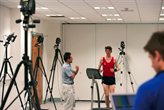Aimed at studying large and complex movements, the Kinesiology Laboratory is a versatile space, with equally versatile equipment.
 The laboratory space can be separated into two parts by a movable partition. The smaller part is double height (10m) with a balcony, allowing the investigation of movements requiring height, such as jumping, trampolining or basketball. The full length of the room enables study of interceptive actions such as catching.
The laboratory space can be separated into two parts by a movable partition. The smaller part is double height (10m) with a balcony, allowing the investigation of movements requiring height, such as jumping, trampolining or basketball. The full length of the room enables study of interceptive actions such as catching.
The laboratory also contains computer-controlled motorized staircases which allow investigations into the perception and energetics of stair climbing. An ‘intelligent walkway’ embedded in the floor presents stepping targets to walking participants with various degrees of advance warning.
The main equipment is a 13 camera Vicon system, which carries out 3D motion analysis. This can be coupled with the two Kistler force plates for posture analysis and Delsys EMG systems for evaluating the physiological properties of muscles.
Related projects
Research in the laboratory addresses three broad themes:
-
Perception and action
-
Programmed control
-
Sporting performance
Researchers study the neural processes underlying the healthy control of movement and posture and how these processes change in response to ageing, age-related metabolic and neurodegenerative diseases, brain injury (concussion) and damage (stroke), diabetes and diabetic peripheral neuropathy. They measure patterns of brain activation during functional motor tasks and relate them to detailed kinematic information obtained from the motion analysis facilities.
Contact: Dr François-Xavier Li. Tel: 0121 414 4114. Email: f.x.li@bham.ac.uk